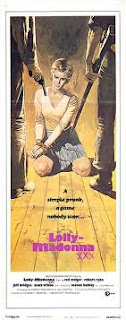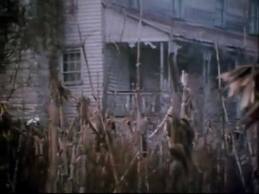God knows, I love me some Kowalski, Super Soul and the nude biker chick who hangs out at Angel's desert pad. I was the underaged kid who needled two different relatives to take me to see Vanishing Point on multiple occasions. I also liked Richard Sarafian's follow up film, the underrated Man in the Wilderness, where Richard Harris almost gets eaten by a bear and John Huston travels overland in a boat Fitzcarraldo-style. That said, neither one of these is my favorite Sarafian film. That would be his following film, 1973's The Lolly-Madonna War (aka Lolly-Madonna XXX).
Based on the Sue Grafton novel, (and if you have a copy, please send it my way, the out-of-print paperback is going for $600 on Amazon) the film tells the story of two feuding hillbilly clans in Tennessee and a traveling girl who becomes an unwilling pawn in their fight.
The story is deceptively complex. On the surface it appears to be simply a feud between two neighbors over an empty meadow. As the story unfolds however, deeper issues and tragedies are revealed. These past tragedies have set up an atmosphere of despair and frustration which in turn provide fertile ground for the resentment between the two neighboring clans to foster. The message that loss and despair breeds self-destructiveness is prevalent throughout the film. There's also a strong anti-war theme here as well. It is nicely woven in, mostly in a subtextual way, and only becomes overt on a few occasions. It never overwhelms the film or becomes preachy. Nevertheless, it makes a bold statement for a 1973 movie when there were few anti-war films being released.
The star power alone elevates this film to one of Sarafian's best with a cast that includes Rod Steiger, Robert Ryan, Jeff Bridges, Scott Wilson, Ed Lauter, Paul Koslo, Gary Busey, Randy Quaid, Kiel Martin and Timothy Scott. It also features the debuts of Season Hubley and Joan Goodfellow. The actors lend a real authenticity to the film, and some subtle but powerful performances. Additionally, there are several surprisingly tender scenes that really give the characters three dimensions and flesh out their relationships. Trying to pick the best performance of the film is tough. Rod Steiger is great as the sweaty, red-faced, tightly-wound Laben, the father of the Feather clan. Jeff Bridges plays the youngest Feather brother, Zack, and has a real nice rapport with Season Hubley's innocent, unworldly character. I can't believe Bridges was this good, this early in his career. Ultimately, I think Scott Wilson puts in the best performance as Thrush, the tortured elder brother who displays both bitterness and compassion very believably. I really bought into his self-destructiveness too.

The Tennessee setting was really nice looking, and made me wish for a better looking print of the film. The houses and costumes looked very authentic and backwoodsy without being stereotypical. The music by Fred Myrow was very good and understated in a haunting kind of way. It always stays in my head a few days after viewing the film.
If you're looking for a serious rural drama like the recent Winter's Bone or Shotgun Stories, check this one out. It's definitely solid across the board, with great performances, an authentic look, and a strong message. It's Safarian's best in my opinion.
9/10
Very Cool - Joan Goodfellow would go on to co-star with Jan Michael Vincent in the superb Buster and Billie.
Not So Much - Unfortunately, Goodfellow never achieved the heights her talent merited.
WTF! - The film was never released on VHS, much less DVD. I consider this a crime against humanity. If you're the least bit curious about it, throw a vote on the TCM site to get it released on video:










No comments:
Post a Comment